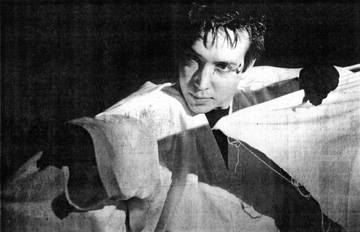



Stephen Nowers/Anchorage Daily News
New take on old tales
Storyteller gives evolution a little push
By Mike Dunham, Anchorage Daily News arts editor
Scrambling for material, he decided to tell a story.
"It was a really weird time, he recalled. "But something kept going in me, kept pounding in my head. I really didn't know what the story was until 15 minutes before I had to go on."
He frantically scratched down four pages of notes and went on with a story titled "The Beginning and the End," unrehearsed and extemporized moment by moment. It created a sensation.
Last year, he received a similar response at the International Storytellers Festival in Whitehorse, Yukon. Next week he'll head for Calgary, Alberta, to conduct workshops and present a new work for that city's Board of Education.
But before he leaves, he wants to show his new piece to the hometown crowd. So, today and tomorrow, Dalton's one-man blend of words, music and motion, "IMAGINOCEAN," will go onstage at Sydney Laurence Theatre.
Dalton, born in Bethel, Alaska, raised in Anchorage, is part Yup'ik and part European by birth. A graduate of East High School and the University of Alaska Anchorage, his day job was public relations, for which he has won statewide awards. "IMAGINOCEAN" includes some of that attention to proportion, polish and , well, slickness. But it departs from commercial work in its spontaneous spirit and highly improvised nature.
"The thing about a story is that it doesn't have to be the same every time," he said. "From one might to the next, each story can be very different. Sometimes you'll have the same story, but the moral will change."
The flux in any performance is driven by what Dalton described as his "connection with the audience," tuning into the reaction on the other side of the footlights, divining what the listeners want to hear and adapting the tale to that feeling.
"IMAGINOCEAN" is a bare bones production. "The whole set travels in a garment bag," Dalton said. He appears alone onstage wearing a karate outfit, either black or white, and the opposite color gloves and slippers. His main props are two stick-and-cloth items he call "wings," which are also used to evoke mountain, clouds and other elements in the stories.
The stories mix traditional mythology with postmodern deconstructionism. In Dalton's version of the creation story, told in the first half of the show, Raven, the jokester/creator of Native legend, isn't a before-all-ages-almighty until he "gets the God complex."
In modern times, he's confronted by a skeptical girl who tells him that he's not the creator at all, but just a sill big black bird with nothing useful to impart. That sends a flustered Raven flying around the world in search of himself, finally seeking advice from a mystic in the Far East. The stories are accompanied by ambient music.
"In a small setting, you can tell a story by yourself, "Dalton said. "But if you're working with a larger audience, music sort of hews the emotion. It's really important as far as theatrics go when your trying to create an emotion that the entire audience can feel at the same time."
"IMAGINOCEAN" incorporates theater and dance. But, Dalton said, it's mainly the ancient art of storytelling updated for the new millennium.
"It's the evolution of tradition," he said. "I've received some flak from some of the more staunch arbiters of tradition among Native people. You're changing the story and it's not supposed to be changed,' they say. But evolution is required for something including tradition to survive."
Dalton's conviction that he's doing the right thing receives voice in his version of the creation story when Raven's guru tells him, "Raven can only be what Raven believes he is." The hero then returns to the doubting girl and informs her, "Your just not paying attention to the stories your grandmother tells. But it will not change my mind about who I am."
At least, that's the way it ends right now. Tonight or tomorrow or next month in Calgary, the moral could change.
